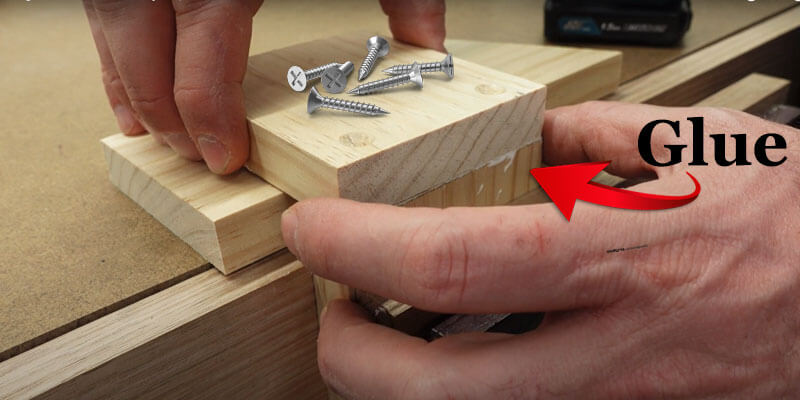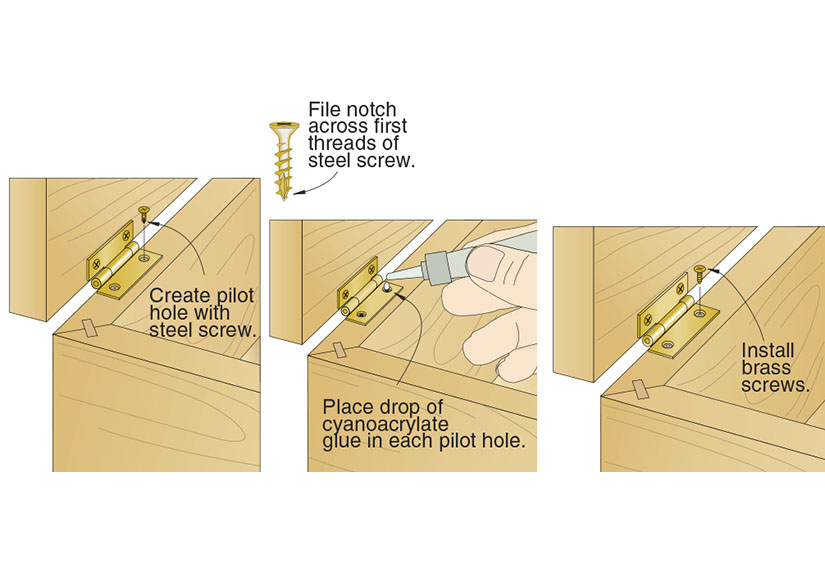If you’ve ever wondered, “Does wood glue hold screws?” Well, you’re in the right place! So, picture this: you’re working on a woodworking project, and you want to make sure those screws stay put. Will wood glue do the trick? Stick around as we dive into the fascinating world of wood glue and screws.
Now, I know what you’re thinking. “But wait, how can glue hold screws?” Good question! It may seem counterintuitive, but wood glue actually plays a crucial role in reinforcing screws and enhancing the overall strength and stability of your project.
In this article, we’ll explore the science behind how wood glue bonds with wood fibers and why it’s a reliable companion for screws. So, grab your safety glasses and join us on this journey to discover the answer to the age-old question: “Does wood glue hold screws?” Let’s get started!

Does Wood Glue Hold Screws?
In the world of woodworking and DIY projects, the question of whether wood glue can hold screws is a common one. Wood glue is commonly used to bond wood pieces together, but can it provide enough strength to hold screws securely in place? In this article, we will explore the effectiveness of wood glue in holding screws and provide you with valuable insights and tips.
Understanding Wood Glue and Its Strength
When it comes to woodworking, wood glue is a popular adhesive choice. Wood glues, such as PVA (Polyvinyl Acetate) and epoxy, provide a strong bond between pieces of wood by penetrating the fibers and creating a secure connection. However, the strength of wood glue alone may not always be enough to hold screws in place.
Wood glue is primarily designed to provide adhesion between two surfaces, creating a bond that is often stronger than the wood itself. While it can provide an additional layer of strength, it’s important to note that wood glue is not specifically engineered to secure screws. Screws rely on their own threading and grip within the wood to hold it together.
That being said, wood glue can still be used in conjunction with screws to provide added stability and prevent the wood from splitting. By adding wood glue to the screw holes before inserting the screws, you can reinforce the connection and reduce the chance of the wood splitting over time.
The Benefits of Using Wood Glue with Screws
While wood glue may not be the primary method of securing wood with screws, there are still several benefits to using it in conjunction with screws:
- Added Strength: Applying wood glue to the screw holes can increase the overall strength of the joint, making it more resilient and less likely to loosen over time.
- Prevention of Splits: By pre-drilling the screw holes and adding wood glue, you can help prevent the wood from splitting, especially in hardwoods or when working with thinner materials.
- Improved Aesthetics: Utilizing wood glue can help create a cleaner, seamless appearance by filling in any gaps or imperfections in the wood joints.
When to Rely on Screws Alone
While wood glue can provide additional strength and stability, there are instances where relying on screws alone may be more appropriate:
- Disassemblability: If you anticipate the need to disassemble or make adjustments to your project in the future, using wood glue alone can make it difficult or impossible to separate the wood pieces.
- Time Constraints: When working on time-sensitive projects, relying on screws alone can be more efficient as wood glue requires time to dry and cure before it achieves its full strength.
In these situations, it’s best to use screws without the aid of wood glue. However, it’s always recommended to use pre-drilled holes and select the appropriate screw length and diameter for the wood to ensure a secure and long-lasting joint.
Tips for Using Wood Glue with Screws
Here are some valuable tips to keep in mind when using wood glue in conjunction with screws:
- Preparation: Make sure to clean and dry the surfaces before applying wood glue to ensure a strong bond.
- Apply a Thin Layer: Use a brush, roller, or evenly distribute the wood glue to the surface to avoid excess glue and ensure a strong bond.
- Don’t Overscrew: Avoid overtightening screws, as it can weaken the wood and compromise the joint.
- Allow Drying Time: Follow the manufacturer’s instructions for drying and curing time before subjecting the joint to stress or pressure.
Common Myths About Wood Glue and Screws
There are some common misconceptions about the use of wood glue and screws. Let’s address a few of them:
Myth 1: Wood glue can replace or negate the need for screws.
While wood glue can provide additional strength to a joint, it should not be relied upon as the sole method of fastening wood pieces together. Screws are designed to create their own grip within wood, providing a more secure connection.
Myth 2: Wood glue can repair a loose screw.
If you have a loose screw, wood glue cannot fix the issue. Instead, you should remove the screw, add some toothpicks or wooden dowels coated with wood glue, and then reinsert the screw for a more secure fit.
Myth 3: More wood glue equals stronger bond.
Using excessive amounts of wood glue does not necessarily result in a stronger bond. It can lead to messiness, increased drying time, and potential weakening of the wood itself. Apply a thin, even layer for best results.
Myth 4: All wood glues are the same.
Not all wood glues are created equal. Different types of wood glues have varying properties, drying times, and strength factors. It’s important to select the appropriate type of wood glue for your specific project.
Conclusion
Wood glue can provide added strength and stability when used in conjunction with screws, but it is not a replacement for proper screw fastening. By understanding the role of wood glue and its benefits, as well as knowing when to rely on screws alone, you can create strong and durable wood joints. Remember to follow the recommended tips and techniques to ensure the best results for your woodworking projects.
Key Takeaways: Does Wood Glue Hold Screws?
1. Wood glue can help secure screws in place, providing extra strength to the joint.
2. It’s important to ensure a tight fit between the screw and the wood before applying glue.
3. Wood glue may not be sufficient on its own and should be used as a supplemental measure.
4. The type of wood and the size of the screw can affect the effectiveness of the glue.
5. Ultimately, using wood glue and screws together can create a stronger and more durable bond.
Frequently Asked Questions
When it comes to woodworking projects, using screws along with wood glue is a common practice. However, there may be some confusion about whether wood glue can hold screws securely. To clear things up, here are some frequently asked questions about the topic:
1. Can wood glue hold screws?
Wood glue is not primarily used to hold screws but to strengthen the bond between two pieces of wood. While wood glue can provide some added strength, it is not designed to solely hold screws in place. The main purpose of screws is to provide structural support, while the glue acts as an adhesive to improve the overall strength of the joint.
Therefore, if you’re relying solely on wood glue to hold screws, it may not be sufficient. It’s best to use both screws and wood glue together for a strong and durable connection.
2. What is the role of wood glue in woodworking projects?
Wood glue plays a crucial role in woodworking projects by bonding wood pieces together. It provides extra strength, filling gaps and preventing movement between the joints. When applied correctly, wood glue creates a strong bond that enhances the overall stability and durability of the project.
It’s important to note that there are different types of wood glue available, each with its own unique properties. Some are suitable for interior use, while others are designed for outdoor applications or specialized woodworking projects. Always choose the appropriate wood glue based on your specific needs.
3. Should I rely solely on wood glue or screws for secure joints?
No, relying solely on wood glue or screws for secure joints is not recommended. Both wood glue and screws have their roles in creating strong and stable connections. Wood glue enhances the bond between the wood pieces, reducing the risk of failure due to movement or stress. Screws, on the other hand, provide mechanical strength and hold the joint together.
By using a combination of wood glue and screws, you can achieve the best of both worlds. The glue strengthens the bond, while the screws provide structural support. This combination ensures a secure and durable joint that can withstand the test of time.
4. Can I remove screws that have been glued in place?
While it’s not impossible to remove screws that have been glued in place, it can be challenging. The wood glue creates a strong bond between the screw and the wood, making it more difficult to remove without causing damage. Attempting to remove glued-in screws may result in stripped threads or wood splitting.
If you need to remove screws that have been glued, consider using a heat gun or applying some heat to soften the glue. Be cautious and take your time to avoid damaging the wood. It’s always best to consult a professional or seek advice from experienced woodworkers if you’re unsure about the process.
5. Are there any alternatives to wood glue for holding screws?
Yes, there are alternatives to wood glue for holding screws in place. One option is using construction adhesive, which has similar bonding properties to wood glue but is specifically designed for securing screws and other fasteners. Construction adhesive provides a strong and durable bond, ensuring that the screws stay in place.
Another alternative is using epoxy resin. Epoxy provides excellent bonding strength and can be used to reinforce screws in woodworking projects. It’s essential to follow the manufacturer’s instructions when using any adhesive to ensure proper application and maximum effectiveness.

Fix Stripped Screw Holes – 3 MINUTE FIX!
Summary
Wood glue can hold screws, but it is not as strong as using traditional screwing methods. The glue helps to secure the screws in place and provide extra support, but it should not be relied upon solely. For stronger and more reliable connections, it is recommended to use screws in conjunction with wood glue.
While wood glue holds well under normal circumstances, it may not hold up against heavy loads or constant movement. It is important to consider the specific application and the weight or stress that will be put on the joint. Overall, using both screws and wood glue together is the best approach for creating strong and durable connections in woodworking projects.
